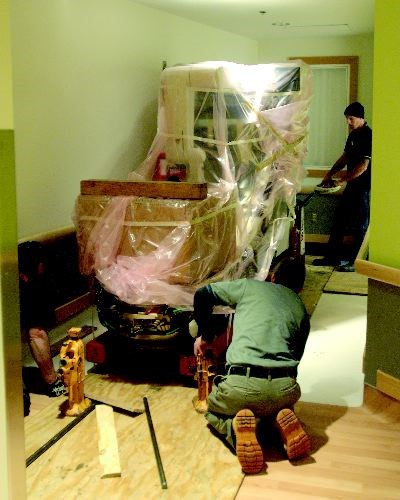It was a tight squeeze pushing through the bends of the treatment room corridor, but the largest pieces of the linear accelerator puzzle are now in place at the BC Cancer Centre for the North.
It was a proud day Wednesday for Hal Collier, chief project manager for the Northern Cancer Control Strategy, knowing a state-of-the-art component is now in place which, by the end of the year, will allow cancer patients to receive radiation treatments in Prince George.
The $3 million accelerator will allow clinicians to more accurately target tumours and deliver more precise beams of radiation in higher doses than what was possible with older technology. The radiation kills or shrinks cancer cells.
"It's a very expensive, very complex piece of equipment which is at the heart of the care delivery for the centre," said Collier. "It's brand-new for the North, not something that's been available up here before.
"This is the last piece of the hard construction. We are completely on track. As we go forward, there's a lot of operational work that needs to be done, hiring the final team of people and training them."
Made in Palo Alto, Calif., by Varian Medical Systems, the accelerator's arm pivots and the patient bed rotates to allow pinpoint alignment of the radiation beam at any angle. The TrueBeam technology delivers more intense doses of radiation, so less time will be required for each treatment. Imaging tools allow the machine operator to see the tumour before and during treatment, and release of the radiation can be timed between each breath of the patient, increasing accuracy to make treatments safer, with less risk of adverse side effects.
The vault where the accelerator is installed is encased in concrete walls two feet thick sheeted with lead-lined drywall. No doors exist to block entrance to the treatment room. The bent configuration of the hallway and an alarm system that shuts the accelerator off if a beam of light in broken provides security to ensure only the patient is present in the room during radiation treatments.
Each accelerator will be capable of treating 10 to 12 patients per day.
"The capacity of these two vaults will easily be able to handle every patient needing this treatment for a decade," said Collier. "We're good for quite a while."
Construction of several areas of the building had to be virtually complete before installation of the accelerators. The computer and electrical system that make them operational were needed immediately to allow the extensive equipment testing process to begin. Once those hookups are in place, medical staff licensed to operate the accelerators will perform a series of tests before they can be certified to be used on patients. Collier said that will take months to achieve.
The second linear accelerator is scheduled to be installed at the cancer centre next week. Each accelerator comes in 30 pieces, which will be assembled by the transport team, H & H Installations. The construction phase will be complete in the summer and at that point Collier said the building will be turned over to the operators of the cancer clinic.



